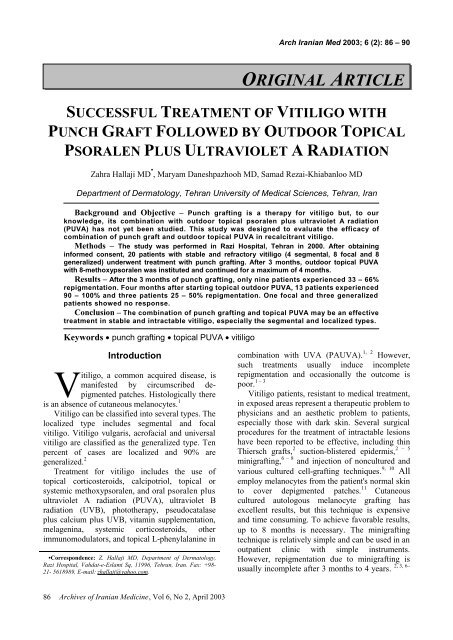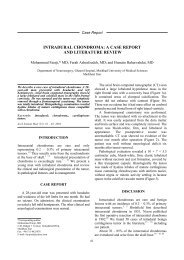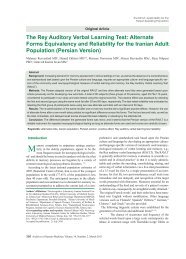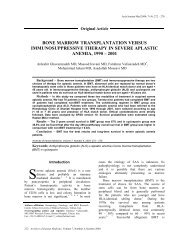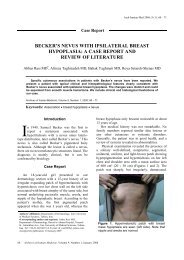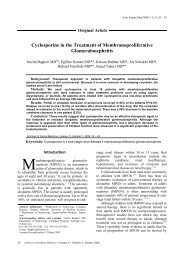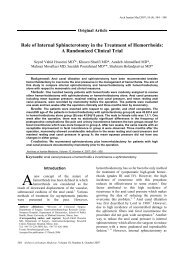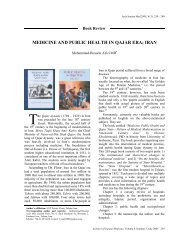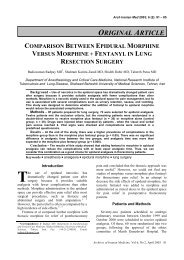SUCCESSFUL TREATMENT OF VITILIGO WITH PUNCH GRAFT ...
SUCCESSFUL TREATMENT OF VITILIGO WITH PUNCH GRAFT ...
SUCCESSFUL TREATMENT OF VITILIGO WITH PUNCH GRAFT ...
- No tags were found...
Create successful ePaper yourself
Turn your PDF publications into a flip-book with our unique Google optimized e-Paper software.
Arch Iranian Med 2003; 6 (2): 86 – 90<strong>SUCCESSFUL</strong> <strong>TREATMENT</strong> <strong>OF</strong> <strong>VITILIGO</strong> <strong>WITH</strong><strong>PUNCH</strong> <strong>GRAFT</strong> FOLLOWED BY OUTDOOR TOPICALPSORALEN PLUS ULTRAVIOLET A RADIATIONZahra Hallaji MD • , Maryam Daneshpazhooh MD, Samad Rezai-Khiabanloo MDDepartment of Dermatology, Tehran University of Medical Sciences, Tehran, IranBackground and Objective – Punch grafting is a therapy for vitiligo but, to ourknowledge, its combination with outdoor topical psoralen plus ultraviolet A radiation(PUVA) has not yet been studied. This study was designed to evaluate the efficacy ofcombination of punch graft and outdoor topical PUVA in recalcitrant vitiligo.Methods – The study was performed in Razi Hospital, Tehran in 2000. After obtaininginformed consent, 20 patients with stable and refractory vitiligo (4 segmental, 8 focal and 8generalized) underwent treatment with punch grafting. After 3 months, outdoor topical PUVAwith 8-methoxypsoralen was instituted and continued for a maximum of 4 months.Results – After the 3 months of punch grafting, only nine patients experienced 33 – 66%repigmentation. Four months after starting topical outdoor PUVA, 13 patients experienced90 – 100% and three patients 25 – 50% repigmentation. One focal and three generalizedpatients showed no response.Conclusion – The combination of punch grafting and topical PUVA may be an effectivetreatment in stable and intractable vitiligo, especially the segmental and localized types.Keywords • punch grafting • topical PUVA • vitiligoORIGINAL ARTICLEIntroductionVitiligo, a common acquired disease, ismanifested by circumscribed depigmentedpatches. Histologically thereis an absence of cutaneous melanocytes. 1Vitiligo can be classified into several types. Thelocalized type includes segmental and focalvitiligo. Vitiligo vulgaris, acrofacial and universalvitiligo are classified as the generalized type. Tenpercent of cases are localized and 90% aregeneralized. 2Treatment for vitiligo includes the use oftopical corticosteroids, calcipotriol, topical orsystemic methoxypsoralen, and oral psoralen plusultraviolet A radiation (PUVA), ultraviolet Bradiation (UVB), phototherapy, pseudocatalaseplus calcium plus UVB, vitamin supplementation,melagenina, systemic corticosteroids, otherimmunomodulators, and topical L-phenylalanine in•Correspondence: Z. Hallaji MD, Department of Dermatology,Razi Hospital, Vahdat-e-Eslami Sq, 11996, Tehran, Iran. Fax: +98-21- 5618989, E-mail: zhallaji@yahoo.com.combination with UVA (PAUVA). 1, 2 However,such treatments usually induce incompleterepigmentation and occasionally the outcome ispoor. 1 – 3Vitiligo patients, resistant to medical treatment,in exposed areas represent a therapeutic problem tophysicians and an aesthetic problem to patients,especially those with dark skin. Several surgicalprocedures for the treatment of intractable lesionshave been reported to be effective, including thinThiersch grafts, 2 suction-blistered epidermis, 2 – 5minigrafting, 6 – 8 and injection of noncultured and9, 10various cultured cell-grafting techniques. Allemploy melanocytes from the patient's normal skinto cover depigmented patches. 11 Cutaneouscultured autologous melanocyte grafting hasexcellent results, but this technique is expensiveand time consuming. To achieve favorable results,up to 8 months is necessary. The minigraftingtechnique is relatively simple and can be used in anoutpatient clinic with simple instruments.However, repigmentation due to minigrafting is2, 3, 6–usually incomplete after 3 months to 4 years.86Archives of Iranian Medicine, Vol 6, No 2, April 2003
Z. Hallaji, M. Daneshpazhooh, S. Rezai-KhiabanlooABFigure 1. Photograph of patient No. 8 showing a vitiligo lesion on the forehead (20 cm 2 ): A) beforegrafting; and B) 7 months after grafting, showing 90% repigmentation.8 On the other hand, PUVA, either systemic ortopical, increases the number of melanocytes andsynthesis of melanin. 1, 4, 5 Topical outdoor PUVA isa popular, practical and efficacious therapeuticoption for patients with limited vitiligo. 12 Themechanism of PUVA rests on the synergisticinteraction of the two components (8-methoxypsoralen and UVA light) in the skin. 13 Weconducted this study to evaluate the efficacy ofcombining punch grafting and topical outdoorPUVA in vitiligo patients.Patients and MethodsTwenty Iranian patients (12 women and 8 men,in the age renge of 13 – 40 years) with stablevitiligo underwent minigrafting in Razi Hospital,Tehran in 2000. The disease was segmental in four,focal in eight and generalized in eight cases. Allsubjects were otherwise healthy. They had beenresistant to systemic or topical methoxypsoralenand topical steroid therapies for at least 1 year.They showed neither spread of existing lesions nordevelopment of new lesions during the previous 6months. Patients under 12 years of age, pregnantand lactating women, and those with a history ofphotosensitivity or skin cancer were excluded fromthe study. After obtaining informed consent, onepatch was grafted in each patient without previousminigrafting test.The grafting site was prepared by infiltration of1% lidocaine without epinephrine followed byperforation of recipient holes of 1.5 mm deep and2.5 mm apart from each other. Minigrafts wereharvested from the gluteal region for the trunk andlimb regions, and the back of the ear for the facelesions; punches of 2 mm in size were placedwithin the recipient holes. Dressings were removed2 weeks later and all subjects observed twosessions per month for 3 months. Repigmentationrate was scored visually. Graft rejection wasdetermined as necrosis of the grafs in the recipientholes.All subjects applied 8-methoxypsoralen (0.1%alcoholic solution) and received sunlight for threesessions per week, for a maximum of 4 months.The first exposure time was 15 seconds and wasincreased by 10 seconds per session until theappearance of a slight erythema. Treatment wascontinued until complete repigmentation occurred,or for 4 months. If no evidence of repigmentationwas observed by this time, treatment wasdiscontinued and repigmentation was scored. Dataare presented as mean ± standard deviation.ResultsThree months after punch grafting, only nine(45%) patients experienced 33 – 66% repigmentation(partial repigmentation). The onset ofrepigmentation was between 28 and 45 days (35.3± 7.5). Further repigmentation stopped between 45and 75 days (61.7 ± 9.0). Four months after theinstitution of topical outdoor PUVA, 13 patientsexperienced 90 – 100% repigmentation (completeArchives of Iranian Medicine, Vol 6, No 2, April 2003 87
Successful Treatment of Vitiligo with Punch Graft and PUVATable. Demographic and results of 20 patients with vitiligo treated with punch graft and topical PUVA.Size ofNo. ofRepig. onset after Repig.Age/ treated TypeRepig. after SkinpatientArea graft/the end of aftersex lesion (disease)PUVA (%) type(cm 2 repig. after graft graft (%))1 16/F 75 Segmental Trunk 45/60 50 90 4 82 20/M 9 Generalized Face 45/60 33 99 3 —3 16/F 6 Focal Lt foot 35/60 33 100 2 —4 17/M 4 Generalized Face —/— — 99 3 —5 25/F 8 Generalized Rt hand 30/75 33 99 4 16 15/M 4 Focal Face —/— — 99 2 —7 23/M 6 Focal Face 30/60 66 99 3 18 40/F 20 Segmental Face 30/60 33 95 2 —9 27/M 15 Focal Trunk 28/60 66 90 3 210 21/F 8 Segmenta Trunk —/— — 99 2 —11 15/F 3 Focal Rt shin 45/75 75 33 3 —12 22/M 8 Segmenta Face 30/60 66 99 4 —13 13/F 6 Focal Face —/— — 95 2 —14 13/F 3 Focal Trunk —/— — — 3 —15 27/F 8 Generalized Lt wrist —/— — — 4 —16 25/F 9 Generalized Lt wrist —/— — — 3 —17 14/F 8 Generalized Lt hand —/— — — 3 —18 24/F 10 Generalized Lt hand —/— — 50 3 219 17/M 2.25 Focal Face —/— — 50 2 —20 19/M 7 Generalized Face —/— — 25 2 —Lt = Left; Rt = right; Repig. = repigmentation.response) and three patients 25–50% repigmentation(partial). Four patients showed no response.The mean onset of repigmentation was at 25.6sessions (SD, 5.9 sessions). The results aresummarized in the Table.Nine patients who responded to punch grafting(33–66% repigmentation) showed completerepigmentation after PUVA. Punch grafting alonewas unsuccessful in four of the patients whoresponded completely and in the three patients whoresponded partially (25–50%) to the combinationof punch grafting and PUVA. Three (75%)responders had truncal, seven (70%) facial andthree (50%) limb lesions. All subjects of segmentaltype, six (25%) subjects of localized type and three(38%) subjects of generalized type experienced90–100% repigmentation (Figures 1 and 2).The Kobner phenomenon was observed in threepatients (2 patients with varying shape and size ofrecipient facial area and 1 in donor site).Cobblestoning was observed in 11 patients, butspontaneously resolved between 7 and 18 monthslater. Graft rejection was observed in only 14 (3%)out of 445 grafts.DiscussionFalabella pioneered the use of small autotransplantfor the treatment of four patients withsegmental vitiligo in 1983. 7, 8 In 1988, he treated 22patients with localized vitiligo after three to fiveminigraft tests by this method. Thirteen patientsRejectedgraftobtained 90 – 100% repigmentation. 8Westerhof et al also observed satisfactoryresults using minigrafting in stable leukoderma. 6Boersma et al evaluated autologousminigrafting followed by UVA (10 J/cm 2 ) twice aweek in stable vitiligo vulgaris and found iteffective in a selected group of patients. Theresults of 19 patients were analyzed, showing 80 to99% repigmentation in 14 lesions, 50 to 80%repigmentation in 10 lesions, and zero to 50%repigmentation in 12 lesions. 2Although minigrafting can be an effectivetreatment in vitiligo, failure to achieve completerepigmentation in a high percentage of patients2, 3, 6 – 8remains a major drawback.The potential of PUVA to increase the numberof melanocytes prompted us to use autologousminigrafting followed by topical outdoor PUVA in20 patients with stable vitiligo (segmental,vulgaris, and focal). We did not perform aminigraft test.In the first phase of our study, only ninepatients showed partial repigmentation (33 – 66%)by minigrafting. Repigmentation progressedmainly during the first 2 months and remainedstable afterward, despite the sunny climate.The addition of topical PUVA increased therate of repigmentation significantly. Repigmentationreached 90 – 100% in 13 patients (includingthose patients who were responding tominigrafting). Three nonresponders to minigraftingshowed 25 – 50% repigmentation with the addition88Archives of Iranian Medicine, Vol 6, No 2, April 2003
AZ. Hallaji, M. Daneshpazhooh, S. Rezai-KhiabanlooBABFigure 2. Photograph of patient No. 1 showing a vitiligo lesion on the trunk (75 cm 2 ): A) beforegrafting; and B) 7 months after grafting, showing 90% repigmentation.of PUVA, while four patients (3 generalized, and 1localized) showed no repigmentation despite theaddition of PUVA.Fitzpatrick skin type IV patients respondedbetter than other types. Also, the response rate washigher on the trunk, followed by the face andextremities. Segmental vitiligo responded betterthan focal type. The least responsive group was thegeneralized type. Complete response to PUVA infour nonresponders to minigrafting and partialresponse in three nonresponders was an interestingfinding in our study. This can be explained by theeffect of methoxypsoralen plus UVA on thedonor’s melanocytes.Kobner phenomenon was seen in two patientsafter minigrafting at recipient sites and in anotherone at the donor site. Cobblestoning was seen in55% of patients. Repigmentation was nearlyuniform.After 1 year of follow-up, no hyperpigmentationwas seen and only cosmetically acceptablemild cobblestoning was noted in 7 patients andresolved in others. Other possible side effects suchas infection, hypertrophic scarring, keloids,persistent pigmentary changes and necrosis of thegrafts were not seen. The combination of punchgrafting and topical PUVA was an effectivetreatment in a small group of stable and intractablevitiligo, especially segmental and localized types.We suggest further studies to evaluate whetherearlier institution of PUVA after minigrafting leadsto an earlier satisfactory response. Also, wesuggest comparing this method with othertechniques such as Thiersch grafting andsuctioning blister epidermis in combination withPUVA or narrow-band UVB phototherapy infurther studies.References1 Grimes PE. Therapies for vitiligo. In: Millikan LE,ed. Drug Therapy in Dermatology. 1st ed. New York:Marcel Dekker; 2000: 339 – 57.2 Boersma BR, Westerhof W, Bos JD. Repigmentationin vitiligo vulgaris by autologous minigrafting: resultsin nineteen patients. J Am Acad Dermatol. 1995; 33:990 – 5.3 Falabella R. Surgical techniques for repigmentation.In: Robinson JK, Arndt KA, LeBoit PE, et al, eds.Atlas of Cutaneous Surgery. 1st ed. Philadelphia: WBSaunders; 1996: 175 – 84.4 Suga Y, Butt KI, Takimoto R , et al. Successfultreatment of vitiligo with PUVA-pigmentedautologous epidermal grafting. Int J Dermatol. 1996;35: 518 – 22.5 Ai-Young L, Jeong-Hoon J. Autologous epidermalgrafting with PUVA-irradiated donor skin for thetreatment of vitiligo. Int J Dermatol. 1998; 37:551 – 4.6 Westerhof W, Nieuweboer-Krobotova L, Mulder PG,et al. Left-right comparison study of the combinationof fluticasone propionate and UV-A vs eitherfluticasone propionate or UV-A alone for the longtermtreatment of vitiligo. Arch Dermatol. 1999; 135:1061 – 6.7 Falabella R. Repigmentation of segmental vitiligo byautologous minigrafting. J Am Acad Dermatol. 1983;9: 514 – 21.8 Falabella R. Treatment of localized vitiligo byautologous minigrafting. Arch Dermatol. 1988; 124:1649 – 55.9 Gauthier Y, Surleve-Bazeilla JE. Autologous graftingwith noncultured melanocytes: a simplified methodfor treatment of depigmented lesions. J Am AcadArchives of Iranian Medicine, Vol 6, No 2, April 2003 89
Successful Treatment of Vitiligo with Punch Graft and PUVADermatol. 1992; 26: 191 – 4.10 Lerner AB. Repopulation of pigment cells in patientswith vitiligo. Arch Dermatol. 1988; 124: 1701 – 2.11 Marwa A, Mohamed B. Efficacy of nonculturedmelanocytes transplantation versus minigrafting invitiligo. Gulf J Dermatol Venerol. 2001; 2: 25 – 35.12 Grimes PE. Therapeutic trends for the treatment ofvitiligo. J Cosm Dermatol. 2002; 6: 21 – 5.13 Shephard SE, Langguth P, Panizzon RG.Pharmacokinetic behavior of sublinguallyadministered 8-methoxypsoralen for PUVA therapy.Photodermatol Photoimmunol Photomed. 2001; 17:11 – 21.90Archives of Iranian Medicine, Vol 6, No 2, April 2003


